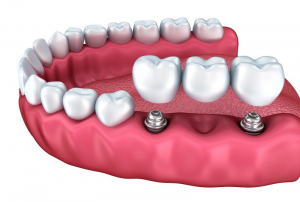Frequently Asked Questions
How is a bridge made and fitted?
Having a bridge fitted is a similar procedure to that of a crown. The teeth either side of your gap will be filed into the correct shape to receive the crowns that hold the bridge in place. Dental impressions will be used by an external technician to create a bespoke restoration for you, and you’ll be fitted with a temporary bridge while you wait. When your bridge is ready, you’ll return to the dentist to have it permanently secured in place.
My gap isn’t that noticeable – why bother with a bridge?
Whether you are missing a single tooth or multiple teeth, it is important to consider a replacement, even if your gap isn’t causing you any concern. Over time your remaining teeth will begin to shift, putting pressure on other teeth and potentially affecting your bite function and facial bone structure. A bridge provides both a functional and an aesthetic solution.
How long will my bridge last for?
Look after it properly, following your dentist and hygienist’s advice, and you can expect your bridge to last for upwards of 10-15 years.
Root canals (endodontics)
Root canal treatment is often required when the pulp inside the tooth becomes infected, usually due to damage to the tooth or advanced tooth decay. The treatment involves removing the infected pulp tissue from inside the tooth, cleaning it up to ensure no infection remains and filling the space to seal it and protect the root canal from further infection. The treatment is often concluded with the placement of a crown to reinforce the affected tooth.
Root canal and pain – busting the myth
The term ‘root canal’ has a bad image – a hangover from the early 20th century, when treatments could indeed be rather unpleasant. But while the misconception about root canal has lingered in the public consciousness, today’s treatment is not only seriously high-tech, but pain-free, too. The procedure itself is carried out under local anaesthetic, and though some patients may find the tooth feels a little sensitive for a few days afterwards, it is low-level discomfort that can be relieved with over-the counter-medication. Following a root canal, the vast majority of patients report back on how wonderful it is to have relief from the pain of the pulp infection.
Spot the early signs
Early indicators that you might require root canal treatment include sensitivity to hot and cold food; toothache; and pain while chewing or drinking. Many patients put up with this discomfort and find that it eventually subsides – but this is often a false alarm! Symptoms may subside when the infection causes the sensitive dental pulp to die off – but this is only temporary. As the infection spreads to the root canal, symptoms return with more intensity, often accompanied by gum and facial swelling, darkening of the tooth, and even an abscess. At Binley Woods, we advise patients to get in touch as early as possible if they experience any symptoms, and if the pain is severe, book an emergency appointment immediately.
 Unlike dentures, bridges can’t be removed, so they offer extra stability, with none of the problems dentures cause, such as slippage or difficulty eating. A bridge is fixed in place with the aid of a crown at each end, attaching to your existing teeth.
Unlike dentures, bridges can’t be removed, so they offer extra stability, with none of the problems dentures cause, such as slippage or difficulty eating. A bridge is fixed in place with the aid of a crown at each end, attaching to your existing teeth.

